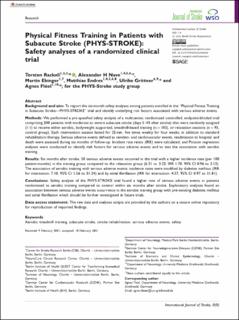| dc.contributor.author | Rackoll, T. | |
| dc.contributor.author | Nave, A. H. | |
| dc.contributor.author | Ebinger, M. | |
| dc.contributor.author | Endres, M. | |
| dc.contributor.author | Grittner, U. | |
| dc.contributor.author | Flöel, A. | |
| dc.date.accessioned | 2021-10-06T11:31:02Z | |
| dc.date.available | 2021-10-06T11:31:02Z | |
| dc.date.issued | 2021 | |
| dc.identifier.citation | Rackoll T, H Nave A, Ebinger M, Endres M, Grittner U, Flöel A. Physical Fitness Training in Patients with Subacute Stroke (PHYS-STROKE): Safety analyses of a randomized clinical trial. International Journal of Stroke. April 2021. | en_US |
| dc.identifier.uri | https://hdl.handle.net/11250/2788118 | |
| dc.description.abstract | Background and aim
To report the six-month safety analyses among patients enrolled in the “Physical Fitness Training in Subacute Stroke—PHYS-STROKE” trial and identify underlying risk factors associated with serious adverse events.
Methods
We performed a pre-specified safety analysis of a multicenter, randomized controlled, endpoint-blinded trial comprising 200 patients with moderate to severe subacute stroke (days 5–45 after stroke) that were randomly assigned (1:1) to receive either aerobic, bodyweight supported, treadmill-based training (n = 105), or relaxation sessions (n = 95, control group). Each intervention session lasted for 25 min, five times weekly for four weeks, in addition to standard rehabilitation therapy. Serious adverse events defined as cerebro- and cardiovascular events, readmission to hospital, and death were assessed during six months of follow-up. Incident rate ratios (IRR) were calculated, and Poisson regression analyses were conducted to identify risk factors for serious adverse events and to test the association with aerobic training.
Results
Six months after stroke, 50 serious adverse events occurred in the trial with a higher incidence rate (per 100 patient-months) in the training group compared to the relaxation group (6.31 vs. 3.22; IRR 1.70, 95% CI 0.96 to 3.12). The association of aerobic training with serious adverse events incidence rates were modified by diabetes mellitus (IRR for interaction: 7.10, 95% CI 1.56 to 51.24) and by atrial fibrillation (IRR for interaction: 4.37, 95% CI 0.97 to 31.81).
Conclusions
Safety analysis of the PHYS-STROKE trial found a higher rate of serious adverse events in patients randomized to aerobic training compared to control within six months after stroke. Exploratory analyses found an association between serious adverse events occurrence in the aerobic training group with pre-existing diabetes mellitus and atrial fibrillation which should be further investigated in future trials.
Data access statement
The raw data and analyses scripts are provided by the authors on a secure online repository for reproduction of reported findings. | en_US |
| dc.publisher | International Journal of Stroke | en_US |
| dc.rights | Navngivelse 4.0 Internasjonal | * |
| dc.rights.uri | http://creativecommons.org/licenses/by/4.0/deed.no | * |
| dc.subject | aerobic treadmill training | en_US |
| dc.subject | subacute stroke | en_US |
| dc.subject | stroke rehabilitation | en_US |
| dc.subject | serious adverse events | en_US |
| dc.subject | safety | en_US |
| dc.subject | nevrologiske lidelser | en_US |
| dc.title | Physical Fitness Training in Patients with Subacute Stroke (PHYS-STROKE): Safety analyses of a randomized clinical trial | en_US |
| dc.type | Journal article | en_US |
| dc.source.journal | International Journal of Stroke | en_US |
| dc.identifier.doi | https://doi.org/10.1177%2F17474930211006286 | |

